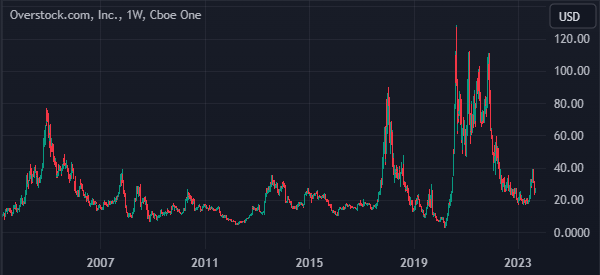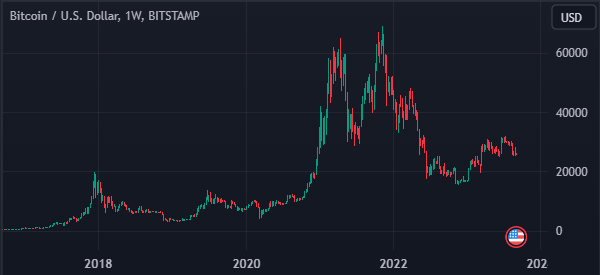A bubble is defined as a situation where people inflate the price of an asset and it moves above its intrinsic value. Bubbles are caused by increased enthusiasm and greed among investors and traders. In most cases, bubbles usually tend to burst suddenly or deflate gradually.
Bitcoin and other cryptocurrencies are some of the most recent bubbles in the financial market. For example, the crypto bubble led to a surge in Non-Fungible Tokens (NFTs), which were once valued at billions of dollars.
In this article, we will explore some of the top historic bubbles and examine Bitcoin.
Table of Contents
How bubbles form | stages of bubbles
Bubbles tend to have similar characteristics when they are forming. In the past, analysts have identified five key stages that these bubbles go through, including:
Displacement
This is the first stage of a bubble. It is when investors identify a new trend they believe will be the next big thing. There are several perfect examples of this.
In 2023, we saw a huge inflow in AI assets like Nvidia and C3.ai. Other examples are electric vehicles, clean energy, cryptocurrencies, and NFTs.
Boom
This is the stage where prices start rising gradually as some investors start allocating money to these assets.
In this period, many analysts start covering the asset. Mainstream media then gets attracted to the asset, leading to more awareness.
Euphoria
In this stage, an euphoria starts and everyone starts talking about the asset. They also start buying it to avoid the fear of missing out (FOMO). People use their savings and borrowed funds to invest in the asset.
Profit taking
This is usually the start of the end of the spectacular rally. It is a period where some big investors start taking profits.
In this time, these assets see their prices start dropping gradually. As this happens, some investors continually buy the dip.
Panic
The final stage is known as panic. It is where people who invested in the asset start to take profits. In this stage, the price crashes rapidly as most investors rush to the exit.
Past example of bubbles
In the 17th century, in the Netherlands, people started buying tulip, which was imported from Turkey. Many people borrowed heavily to invest in the new flower. As the price continued moving up, they continued buying more. Ultimately, the price of tulips dropped and many people lost money.
The same thing happened in the 70s when two heirs started to hoard silver. This was after the end of the Bretton Woods agreement and the price of gold was rising. After inheriting a fortune, they decided to invest the money in silver. They expected its price to track that of gold and it did.
The price moved from below $20 to more than $50. To increase their returns, they borrowed heavily. Ultimately, the price started to drop and the two brothers went bankrupt.
Another recent bubble was in Kenya, where the price of quail birds started to rise. This happened as more people started being aware about the nutritional value of quail eggs. Within less than 6 months, the price of quails moved from around $3 to more than $10. Ultimately, the price dropped because there was no demand for the eggs.
In the stock market, a recent bubble happened in the late 90s. At the time, investors were so enthusiastic about the technology sector and they were buying anything with a dot com name. As the acquisition binge continued, most investors realized that their investments were worthless. This led to the so-called dot com bubble.
The Bitcoin Bubble
Unfortunately, the long road for the cryptocurrencies appears to be coming to an end ten years after it started. Bitcoin started as a way to make anonymous transactions. It started after the financial crisis of 2008, at a time when trust in government institutions was low.
As Bitcoin started getting attention, its price continued. Other currencies started coming up and in 2017, everyone, including in small villages, were investing in Bitcoin. Other currencies like Ripple, Ethereum, and Litecoin came up too.
As this happened, companies started to change their names and strategies. For example, Overstock was a leading e-commerce company. It then changed its strategy and started to focus on cryptocurrencies. As a result, its stock continued to rise.
In 2018 the company was one of the worst performers, and the situation has continued until March 2020 when the pandemic from Covid gave the stock an incredible rally. Today the value has fallen again.

At the end of 2017, their price moved so high that their valuation was more than $800 billion. If the cryptocurrencies were a country, their economy would have been the 19th largest economy. Then, afterwards, the prices started to decline.
The initial Bitcoin bubble burst at the end of 2017 when BTC surged to almost $20,000. In the next few years, the bubble deflated causing Bitcoin to plunge to below $5,000.
Bitcoin Covid-19 bubble
Bitcoin went through another bubble moment during the Covid-19 pandemic. This bubble was triggered by several factors. First, the Federal Reserve and other central banks brought interest rates to a record low. It also flooded the market with dollars through quantitative easing (QE).
As a result, people embraced a risk-on sentiment and moved to risky assets like stocks and cryptocurrencies.
Second, in addition to the Fed, the American government provided trillions of dollars worth of stimulus to the market. Most of this stimulus was in the form of stimulus checks. People funneled these funds to Bitcoin and other new altcoins.
Third, Bitcoin surged because of hype in the industry and as more well-known companies and investors bought the coin. MicroStrategy, a leading IT firm, became the biggest Bitcoin investor. Similarly, Elon Musk also invested in BTC and other coins like Dogecoin.
This bubble led to a major jump in Bitcoin prices. At the time, BTC jumped from less than $5,000 in 2020 to a high of $67,000. Like all bubbles, this rally changed in 2022 and the coin fell back below $16,000.

Key lessons about bubbles
There are several important lessons to learn about how bubbles form and how to be prepared.
First, risk management is an integral part of the financial market. As a trader and investor, you should always work to reduce risks that you expose yourself to.
One of the best strategies to use in a bubble is using a trailing stop-loss. A trailing stop-loss is a tool that stops your trade automatically until it reaches a certain point. Unlike the traditional stop-loss, a trailing stop moves with the asset and captures all profits.
Second, there is a lesson of knowing when there is a bubble or not. In most cases, bubbles have similar characteristics such as euphoria, low interest rates, and a sudden or gradual rise in prices.
Third, you should always diversify your portfolio wisely. This diversification should happen across assets. For example, in addition to investing in crypto, you can also add some money in stocks and bonds.
Summary
The Bitcoin bubble led to substantial losses among many investors as the price crashed from over $67,000 to less than $16,000. In this article, we have looked at how bubbles form and ways to stay safe.
External Useful Resources
- Why The Bitcoin Bubble Will Burst In 2018 – Forbes





